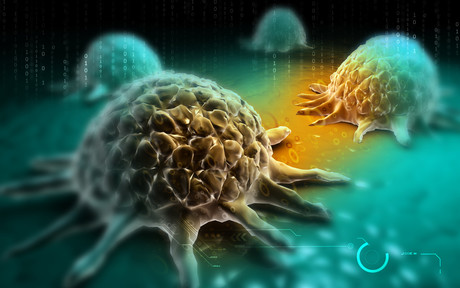Light-emitting particles enable real-time cell imaging

Researchers are combining advances in cell biology, materials science and imaging to create tools that will allow them to track what happens inside a single cell — in real time and in superfine resolution.
For many decades, scientists have relied on using dye molecules that are absorbed into cells to visualise their behaviour. These dye molecules, originally adapted from the dyes used in the textile industry, have undergone development and improvement, but their basic principles and properties remain largely the same.
A major drawback is dimming or fading of the dyes as they’re exposed to the high-intensity light for imaging. Scientists have only a small window of time to image the cell, creating a snapshot of cellular events rather than ongoing, real-time tracking.
Meanwhile, molecular imaging and microscopy have advanced to the point where superfine resolution and real-time imaging is possible, not only at a whole-cell level, but within a cell and of its various components. This is inspiring microbiologists to team up with materials engineers to develop new luminescent biomaterials that, like an aircraft beacon, allow scientists to track and visualise cellular processes without adversely impacting the living cell.
Now, researchers from the University of Technology Sydney (UTS) and the University of Wollongong (UOW), along with colleagues from Peking University and the University of Göttingen, have outlined how light-emitting probes might be applied by life scientists in visualising cellular processes. Their work has been published in the journal Nature Methods.
Distinguished Professor Dayong Jin from UTS said materials scientists have made tremendous progress in the development of novel structures that are extremely small — comparable to the size of a protein molecule — that emit light with greater brightness and precision than classical dye molecules.
“We can take nanomaterials, such as light-emitting plastic or ceramic particles, and deliver them to the site in question,” said Professor Jin, who is lead author on the paper.
“Various other techniques help the particle to pass through the cell wall and we can visualise what is going on inside the molecular machinery,” he continued. One example of the researchers’ advances is the ability to measure the changes in transport within a neuron as a result of brain disease.
“These advanced particles also make it possible to use different colours and pulse signals simultaneously so we can in effect visually barcode genes or proteins to see how these are translated and transcribed — the encoding of life itself,” Professor Jin said.
Distinguished Professor Antoine van Oijen, who leads UOW’s Molecular Horizons initiative, said the study will be critical in illuminating the intricate details of how life works.
“Understanding of disease processes, and thus development of cures, relies on us understanding cellular processes,” he said. “How do the various biomolecules inside our cells do their jobs? What happens when they stop doing their jobs properly and disease strikes?”
He made particular reference to the ongoing antimicrobial resistance crisis, which sees scientists desperate to develop and produce new antibiotics. “Understanding the processes of how drugs work at the molecular level is the key to developing these new drugs,” he said.
Professor Jin is particularly hopeful about the researchers’ breakthrough, stating, “This is an exciting time for the cell biology and materials science communities, who now have an unprecedented opportunity to explore cellular imaging with unprecedented accuracy and resolution.”
Specially designed peptides can treat complex diseases
Two separate research teams have found ways to create short chains of amino acids, termed...
Exposure to aircraft noise linked to poor heart function
People who live close to airports could be at greater risk of poor heart function, increasing the...
Predicting the impact of protein mutations with simple maths
Researchers have discovered that the impact of mutations on protein stability is more predictable...



